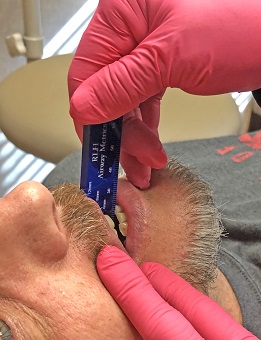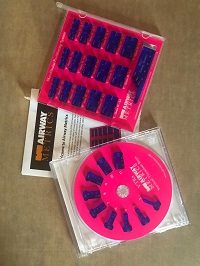Obtaining Oral Appliance Therapy – Powell, OH
Process for Obtaining Oral Appliance Therapy
The patient’s treatment journey begins with the referring physician, who will have administered a sleep test, and, either due to the patient’s noncompliance with CPAP or the patient’s preference, sends the patient to a dental sleep medicine practitioner for an oral appliance. This process and testing requirement laws may vary from state to state.
The dentist’s job in properly treating a sleep apnea patient with an oral appliance involves a set of processes that are undertaken with the goal of identifying the patient’s specific needs, the condition of their mouth and throat, and their systemic health. Once the patient has been thoroughly evaluated, the appropriate device can be selected and fitted, allowing the patient to begin their treatment and follow-up. Outlined here is the standard process used in my office to guide the patient from initial consultation to successful treatment. While each dentist runs his or her office slightly differently, this patient journey is usually followed with the goal of selecting the appropriate appliance and treating the patient’s OSA long-term. Our process is detailed below:
The Initial Appointment
At this appointment, the sleep test is reviewed and interpreted to confirm the patient’s suitability for oral appliance therapy. A review of procedural paperwork, discussion of Ins and Outs of oral appliance therapy and alternative methods is discussed. Your medical history and a screening exam is completed. Selection of appropriate device options is discussed and sample appliances are demonstrated. Disqualifiers for OAT include physical conditions that would make it extremely uncomfortable for the patient to wear an appliance, such as acute temporomandibular joint distress, or gum or dental issues that would prohibit the device’s adherence. A description of the treatment and administrative processes are discussed followed by a preauthorization to the medical insurance provider to pre-determine out-of-pocket expenses to be anticipated for the patient. We practice pre-treatment full disclosure of treatment expectations and expenses.
 The Records Appointment
The Records Appointment
Once the patient is ready to move forward with treatment, we implement several objective tests to aid us in determining the ideal position of which to fabricate the appliance. These tests include Eccovision rhinopharyngometry that uses sound waves to map the internal anatomy of your nasal structures and upper airway. This device assists us in determining patency of structures and severity of a relaxation collapse.
We add the modality of the Airway Metrics system that uses acrylic jigs designed to reposition the vertical opening and horizontal repositioning of the mandible in an effort to more precisely design the custom appliance for efficacy.
 We also perform a Sirona Cone Beam digital panoramic radiograph and a digital cone beam (CBCT) low radiation scan of the upper airway, using specialized software to demonstrate dimensions of the upper airway, noting single or multi-levels of narrowing and the likelihood for oral appliance to be effective. The purpose of the scans is two-fold: to provide a full picture of the mouth, nose, soft tissue and throat in order to use the information to help the appliance to fit properly with optimum effectiveness. Sigitial photographs are taken of the teeth and pre-treatment bite. Additionally, a record of the relationship of the teeth in the desire position is recorded with a bite record and sent to the fabricating laboratory.
We also perform a Sirona Cone Beam digital panoramic radiograph and a digital cone beam (CBCT) low radiation scan of the upper airway, using specialized software to demonstrate dimensions of the upper airway, noting single or multi-levels of narrowing and the likelihood for oral appliance to be effective. The purpose of the scans is two-fold: to provide a full picture of the mouth, nose, soft tissue and throat in order to use the information to help the appliance to fit properly with optimum effectiveness. Sigitial photographs are taken of the teeth and pre-treatment bite. Additionally, a record of the relationship of the teeth in the desire position is recorded with a bite record and sent to the fabricating laboratory.
Selecting an Oral Appliance
After records are completed, an informed decision can be made regarding the most appropriate appliance that will be helpful for the patient. Several factors including size of mouth opening, size and height of tongue, gender, medical history, the apnea severity index (AHI), patient’s body index, TMJ limitations, and range of motion of the jaw, and insurance required appliance design are a few of the deciding factors for design style. Objective tracking compliance chips may also be inserted to track compliance of wear for pilots, truck and bus drivers.
Once the decision is made about the preferred appliance, the records are electronically sent to the lab. The laboratory that we prefer to work with will fabricate the appliance using CAD/CAM technology for a strong pressurized and milled product that is durable yet minimized in bulk because of the fabrication process. These devices also use much less monomer in the process, decreasing the chance for allergic reactions to the product.
One-half of the patient portion for treatment fees are collected at this appointment.
Fitting and Delivery
This appointment is usually pretty straight forward. Once the appliance arrives, the doctor and staff will confirm accuracy of fabrication. During the try-in phase of the appliance, we are evaluating the retention and fit of the appliance as well as the potential for mandibular side and forward movement. Most importantly, we will adjust the appliance to maximize patient comfort while maintaining retention.
We will demonstrate jaw exercises and deliver the morning reprogrammer, to be worn between the upper and lower front teeth every morning for 20-30 minutes. This allows the muscles of the jaw to reprogram back to their normal position, helping to reduce the chance of bite change over time.
Next, the patient and doctor will discuss the process for graduating the jaw into the desired position by activating a simple mechanism within the appliance. An appliance diary (calibration chart) with simple directions is provided to record new positions attained of the lower jaw. We recommend that the patient return for follow-up appointments at a minimum of 1-2 weeks following appliance delivery, then custom prescribed follow-ups to discuss results of a simple test that is periodically performed to determine patient response to the therapy (no additional fee for this testing, only a small supply fee is assessed once). The final half of the patient portion of fees is paid at this delivery appointment. Our administrative staff will submit your insurance claims for you.
Follow-up
Our patients have unlimited office visits at no additional charge for 90 days following delivery of the appliance. After the effective position is determined, a summary of the testing positions is compiled with a letter sent to your referring doctor. You are encouraged to follow-up with your referring physician to complete the final assessment for effective therapy of your apnea. Additionally, a follow-up visit with your sleep medicine dentist is recommended at 6 months and then annually.
